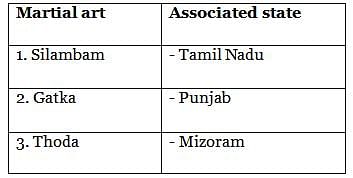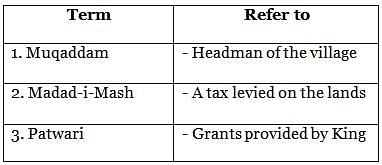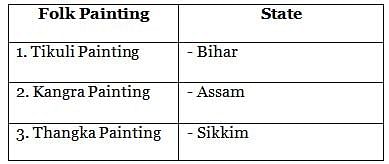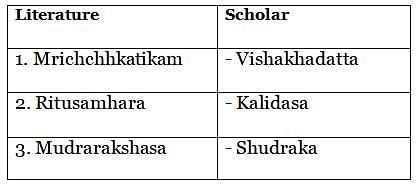Practice Test: Ancient History and Medieval- 1 - UPSC MCQ
30 Questions MCQ Test - Practice Test: Ancient History and Medieval- 1
Consider the following pairs :

Which of the pairs given above is/are correctly matched?

Which of the pairs given above is/are correctly matched?
In the context of medieval India, the 'batai' and 'nasaq' were
| 1 Crore+ students have signed up on EduRev. Have you? Download the App |
With reference to the Rashtrakuta dynasty, consider the following statements:
1. The rulers of the dynasty were strict followers of Shaivism and prohibited the practice of any other religion.
2. Krishna I of the Rashtrakuta dynasty built the Kailasha temple dedicated to Lord Shiv at Ellora.
Which of the statements given above is/are correct?
1. The rulers of the dynasty were strict followers of Shaivism and prohibited the practice of any other religion.
2. Krishna I of the Rashtrakuta dynasty built the Kailasha temple dedicated to Lord Shiv at Ellora.
Which of the statements given above is/are correct?
Consider the following pairs:

Which of the pairs given above is/are correctly matched?
The rock shelters on the banks of the River Suyal at Lakhudiyar, Uttarakhand, bear prehistoric paintings. In this context, which of the following are the characteristics of the Lakhudiyar cave paintings?
1. Hand-linked dancing human figures
2. Absence of animal motifs
3. Humans represented in a stick-like form
4. Use of only white and black colors
Select the correct answer using the code given below.
Consider the following events in Indian History:
1. Ahmad Nagar in the Deccan had declared independence under Malik Ambar
2. Englishmen got consent to establish an English factory in India
3. Mughals captured Golkonda by defeating Abul Hasan
Which of the above events happened during the reign of Jahangir ?
With reference to Mughals architecture, the marble tomb of Rabia ud daurani was built during thereign of :
Consider the following pairs with reference to the Mughals administration :

Which of the pairs given above is/are correctly matched ?
Who among the following is the author of the Hastyayurveda ?
Consider the following statements :
1. It is the capital city of the Ghauri Dynasty, founded by Hoshang Shah.
2. It is a typical representation of the medieval provincial style of art and architecture.
3. The Hindola Mahal, which looks like a railway viaduct bridge, is located here.
The above statements are about ?
In the context of the economic conditions of the Gupta Empire, consider the following statements:
1. The period witnessed an increase in taxes on trade and commerce, while the land taxes were decreased.
2. Villagers were subjected to forced labor by the royal army and officials.
3. Daily transactions by the people residing in the empire were done through the dinars (gold coins).
Which of the statements given above is/are correct?
Consider the following statements with respect to Mahayana Buddhism:
1. Its ultimate goal is 'spiritual upliftment'.
2. The school is more liberal and believes in the heavenliness of Buddha.
3. Its scholars predominantly used Pali as a language.
4. Emperor Kanishka patronized the Mahayana sect of Buddhism.
Which of the statements given above are correct?
In the context of medieval India, the Tulugma System of warfare was used by
Consider the following statements with reference to the Maratha Administration :
1. Walkia-Nawis maintained the records of the king’s activities and the proceedings in the court
2. Summant was responsible for civil and military justice
3. Sari Naubat was in charge of religion, ceremonies and charities
Which of the statements given above is/are correct ?
Which one of the following is the correct chronological order of the later Mughal rulers ?
Consider the following pairs :

How many pairs given above is/are correctly matched ?
Consider the following statements :
1. Thang Ta is the exclusive martial dance form of Sikkim.
2. Bhuta Aradhana is a ritualistic theatre of Karnataka.
3. Singhi Chham is a popular mask dance of Manipur.
Which of the statements given above is/are correct ?
Foreign traveler Visited during the reign of

How many pairs given above is/are correctly matched ?
Consider the following statements with reference to the Coins of Indo-Greeks :
1. They followed an Indian weight standard
2. They had bilingual inscriptions in Greek and Kharoshthi
3. They contain motifs of religious symbols of Indian deities
Which of the statements given above is/are correct ?
Consider the following statements with reference to Kanishka :
1. His empire extended from Central Asia to north India and included Varanasi, Kaushambi and Sravasti in Uttar Pradesh.
2. He convened the fourth Buddhist Council at Purushpura.
3. The Buddhist scholar, Ashvaghosha lived in his court.
Which of the statements given above is/are correct ?
With reference to the Dhokra casting, consider the following statements:
1. It involves casting bronze through the lost wax method.
2. This technique is one of the most prominent metal crafts in the Bastar region of Chhattisgarh.
3. The metal craftsmen of Bastar are called ghadwas.
Which of the statements given above is/are correct?
Which of the following travellers had visited and written about the Vijayanagara Empire?
1. Domingo Paes
2. Fernão Nuniz
3. Niccolao Manucci
Select the correct answer using the code given below.
Consider the following statements with reference to Delhi Sultanate:
1. Delhi became the capital of a kingdom for the first time under Qutub-ud-din- Aibak.
2. Mongol attacks on the Delhi Sultanate increase during the reign of Qutub-ud- din-Aibak and ended forever during the reign of Iltutmish.
3. Mohammad Bin Tughlaq was the first ruler of the Tughlaq dynasty.
Which of the statements given above is/are correct?
In the context of the Mughal period, consider the following statements with reference to Ain-i-Akbari:
1. It was a book written by Abul Fazl in Indo-Persian style
2. The book contains both rules and regulations framed and put into effect for proper administration by Akbar and the social conditions that prevailed during his rule.
Which of the statements given above is/are correct?
Which of the following statements are correct regarding the Mughal paintings?
1. During the reign of Akbar, apart from depicting scenes from the Persian text of Mahabharata, the painters even drew
Persian fables and manuscripts.
2. Due to Indian influence on Mughal paintings, the flat two-dimensional effect of the Persian style was replaced by a three-dimensional effect.
3. Foreshortening technique of creating perspective was an indigenous innovation of the Mughal School.
4. As a trend in the Mughal school a single artist was used to commission an entire painting.
Select the correct answer using the code given below.
Consider the following pairs with reference to the cultural History of India :

How many pairs given above is/are correctly matched ?
Consider the following statements regarding the reign of Sultan Ghiyasuddin Balban of Delhi Sultanate:
1. He promoted people to important positions based on merit without discrimination between Turkish nobles and Indian Muslims.
2. He appointed spies to keep himself well informed.
3. He established the Diwan-i-amir-i-kohi (Department of Agriculture).
Which of the statements given above is/are correct?
Consider the following statements regarding the Nagara style of temple architecture:
1. In the Latina style of temple architecture the buildings are shorter and show a gentle rise as compared to phamsana type.
2. In many Nagara-style temples both phamsana and latina types of shikhara can be seen for manadapa and garbhagriha of a same temple respectively.
3. In the Vallabhi type of architecture buildings have a rectangular roof and are also known as wagon vaulted roofs.
Which of the above statements are correct?
In the context of the cultural heritage of India, which of the following items enjoy Geographical Indication status in India?
1. Aranmula Kannadi
2. Mysore Agarbathi
3. Hmaram
4. Dindigul Locks
Select the correct answer using the code given below.
With reference to Medieval texts, which of the following is/are not an autobiography ?
1. Tuzuk-i-Jahangiri
2. Ain-e Akbari
3. Qanun-i-Humayuni
Select the correct answer from the codes given below :

















